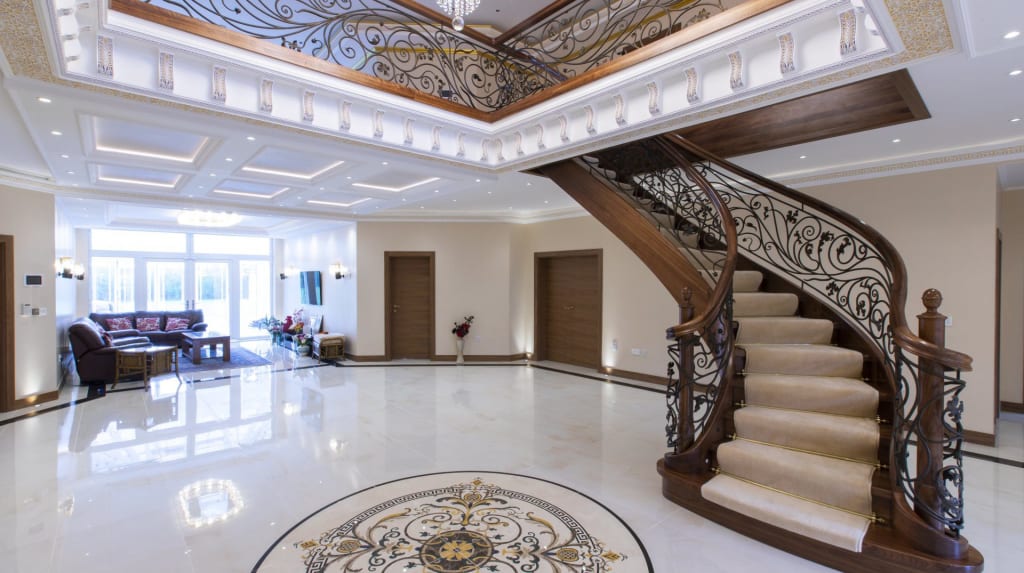
Heritage buildings in the United Kingdom are architectural treasures that provide a glimpse into the nation's rich history and cultural heritage. These buildings often feature intricate craftsmanship and unique design elements, including period-style staircases. Creating period-style staircases that seamlessly blend with the heritage aesthetic requires a deep understanding of historical architecture, meticulous attention to detail, and skilled craftsmanship. This article explores the art of crafting timeless masterpieces—period-style staircases—for heritage buildings in the UK, while emphasizing the importance of preserving the nation's architectural heritage.
1. Understanding Period-Style Staircases
Period-style staircases are an integral part of heritage buildings, reflecting the architectural styles prevalent during specific time periods. From the elegant Georgian spiral staircases to the grandeur of Victorian balustrades, each era has its distinct staircase design characteristics. Understanding the nuances of these styles is crucial for creating period-appropriate staircases that maintain the integrity of the heritage building.
2. Historical Research and Architectural Accuracy
Creating period-style staircases necessitates thorough historical research to ensure architectural accuracy. Architects, designers, and craftsmen involved in these projects delve into archives, historical documents, and architectural records to gather accurate information about the time period in which the heritage building was constructed. This research helps them understand the architectural features, materials, and design elements that were typical during that era, enabling them to recreate the staircase with authenticity.
3. Meticulous Craftsmanship and Materials
Crafting period-style staircases requires exceptional craftsmanship and attention to detail. Skilled artisans utilize traditional woodworking techniques and materials that mirror those used during the building's original construction. Whether it's hand-carving intricate balusters, replicating ornate newel posts, or meticulously recreating period-specific joinery, the craftsmanship involved in these projects is a testament to the dedication of preserving historical accuracy.
4. Balancing Preservation with Modern Safety Standards
While preserving the historical integrity of heritage buildings is paramount, it is equally important to adhere to modern safety standards. When creating period-style staircases, it is necessary to strike a balance between historical accuracy and ensuring the safety of the building's occupants. Designers and craftsmen work closely with structural engineers to incorporate modern structural elements discreetly, ensuring that the staircase meets contemporary safety regulations without compromising its authentic appearance.
5. Collaborative Approach and Expertise
Creating period-style staircases is a collaborative process that involves multiple experts, including architects, designers, craftsmen, and conservation specialists. These professionals work together to seamlessly integrate the staircase into the existing architectural fabric of the heritage building. Their combined expertise ensures that the staircase design aligns harmoniously with the building's overall aesthetics while preserving its historical character.
6. Showcasing Heritage and Preserving Identity
Period-style staircases not only serve a functional purpose but also contribute to the overall narrative of a heritage building. They are an embodiment of the craftsmanship and architectural styles of a bygone era, serving as a visual link to the past. By meticulously creating and preserving these staircases, we safeguard the identity and heritage of the UK's architectural treasures for future generations to appreciate and admire.
7. Adapting to Modern Needs and Accessibility
While honoring historical accuracy, period-style staircases can be adapted to meet modern needs and accessibility requirements. Innovative design solutions such as discreetly incorporating accessibility features or utilizing space-saving techniques can ensure that heritage buildings remain inclusive and functional for all visitors while retaining their period charm.
8. The Process of Creating Period-Style Staircases
Creating period-style staircases for heritage buildings requires a systematic approach that encompasses various stages. From the initial consultation and assessment to the installation and finishing, each step in the process contributes to the creation of a timeless masterpiece.
- Initial Consultation and Assessment
The process begins with an initial consultation where architects, designers, and craftsmen collaborate with the building owners or custodians to understand their vision, goals, and requirements. A thorough assessment of the heritage building is conducted to evaluate its architectural style, existing staircase condition, and any specific challenges or constraints.
- Design and Concept Development
Based on the assessment and client input, the design and concept development phase commences. Architects and designers draw inspiration from historical references and collaborate with the client to develop a design concept that aligns with the building's overall aesthetic and desired functionality. Detailed drawings, sketches, and 3D visualizations are created to provide a clear vision of the proposed staircase design.
- Materials Selection and Sourcing
The selection of materials plays a crucial role in creating an authentic period-style staircase. Architects and craftsmen carefully choose timber, ironwork, and other materials that are historically accurate and match the original building's construction. Sourcing high-quality materials that meet the required standards is essential for ensuring the longevity and authenticity of the staircase.
- Traditional Woodworking Techniques
Craftsmanship takes center stage during the construction of period-style staircases. Skilled craftsmen with expertise in traditional woodworking techniques meticulously carve, shape, and assemble the staircase components. Handcrafted details, such as ornate balusters, intricately carved newel posts, and period-specific joinery, are incorporated to capture the essence of the chosen architectural style.
- Incorporating Modern Safety Standards
While historical accuracy is a priority, modern safety standards cannot be overlooked. Structural engineers collaborate with the design team to ensure that the staircase is structurally sound and complies with relevant building codes and safety regulations. Modern safety features, such as discreetly integrated handrails, non-slip treads, and appropriate lighting, are incorporated into the design without compromising the staircase's authentic appearance.
- 9. Installation and Finishing
The installation phase involves careful coordination between craftsmen, builders, and other tradespeople. The staircase components are expertly installed, ensuring a secure and seamless integration with the heritage building. Finishing touches, such as sanding, staining, or painting, are meticulously applied to enhance the staircase's aesthetic appeal and protect the materials from wear and tear.
9. Case Studies: Iconic Period-Style Staircases in Heritage Buildings
To illustrate the art of creating period-style staircases, several case studies of iconic staircases in heritage buildings across the UK can be explored. Each case study highlights the unique architectural features, design elements, and historical context of the staircase, showcasing the mastery of craftsmanship and the successful integration of period-style staircases into their respective environments.
- The Grand Georgian Spiral Staircase
One such case study could focus on a grand Georgian spiral staircase, highlighting the elegance and sophistication of this architectural style. The article can delve into the characteristic design elements, such as the delicate ironwork, ornate balusters, and sweeping curves that define Georgian staircases. It can showcase examples of Georgian staircases in prominent heritage buildings, such as country estates, Georgian townhouses, or public buildings, and discuss the challenges and considerations in recreating these intricate structures.
- The Victorian Era Balustrades
Another case study could explore the Victorian era and its iconic balustrades. Victorian staircases are known for their ornate detailing, intricate carvings, and use of rich, dark woods. The article can showcase examples of Victorian staircases in historic mansions, museums, or public buildings, discussing the unique design elements and the craftsmanship required to recreate these stunning balustrades. It can also touch upon the influence of technological advancements during the Victorian era on staircase construction, such as the use of cast iron or decorative tiles.
- The Edwardian Elegance
An additional case study could focus on Edwardian-era staircases, characterized by their graceful lines, refined craftsmanship, and lighter color palettes. This section can explore the design characteristics of Edwardian staircases, highlighting examples from country houses, townhouses, or commercial buildings. The article can discuss the challenges faced in replicating the intricate detailing, curved handrails, and delicate spindles that define Edwardian elegance.
10. Challenges and Considerations in Creating Period-Style Staircases
Creating period-style staircases for heritage buildings comes with its own set of challenges and considerations. This section of the article can explore various factors that architects, designers, and craftsmen encounter during the process. It can address topics such as balancing authenticity with functionality, the importance of preservation and restoration techniques, the ethical considerations of conservation, budgetary constraints, and the significance of collaboration and communication between stakeholders.
11. Future Trends and Innovations in Period-Style Staircase Design
The article can conclude with a look at future trends and innovations in period-style staircase design. It can touch upon emerging technologies, such as 3D modeling and printing, that facilitate the recreation of intricate details. It can also discuss the integration of sustainable materials and practices into period-style staircase construction, showcasing the industry's commitment to environmental responsibility while preserving historical authenticity.
Crafting period-style staircases for heritage buildings in the UK is a meticulous and collaborative process that demands a deep appreciation for historical architecture, expert craftsmanship, and a keen eye for detail. By understanding the distinctive features of each architectural era and employing meticulous research and attention to detail, these timeless masterpieces can be created while preserving the identity and heritage of the UK's architectural treasures for future generations to appreciate and admire.





Comments
There are no comments for this story
Be the first to respond and start the conversation.